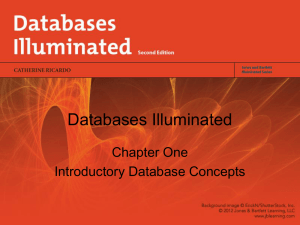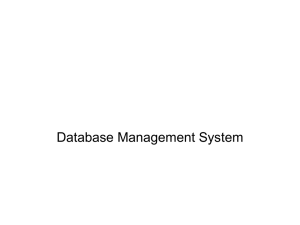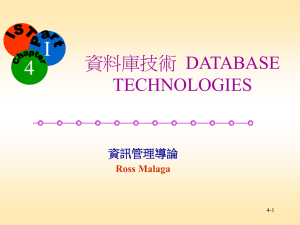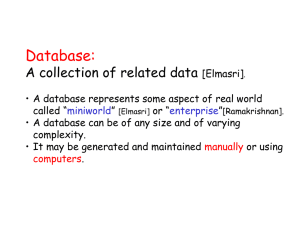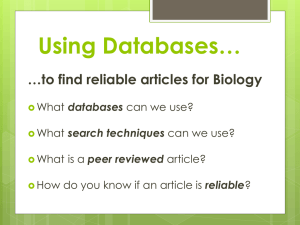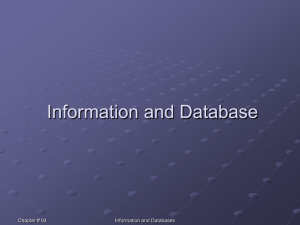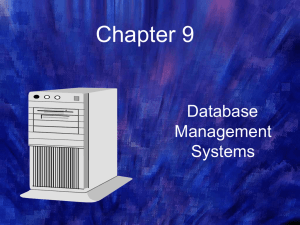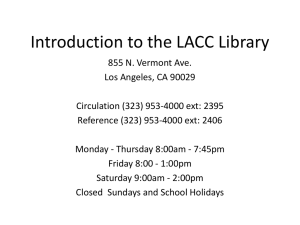Chapter 5 Data Resource Management
advertisement
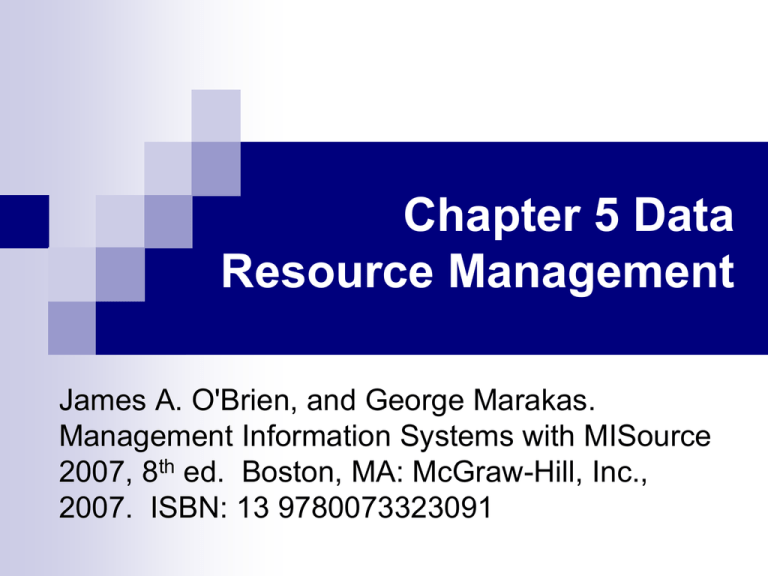
Chapter 5 Data Resource Management James A. O'Brien, and George Marakas. Management Information Systems with MISource 2007, 8th ed. Boston, MA: McGraw-Hill, Inc., 2007. ISBN: 13 9780073323091 Logical Data Elements Chapter 5 Data Resource ManagementChapter 5 2 Logical Data Elements Character A single alphabetic, numeric, or other symbol Field or data item Represents an attribute (characteristic or quality) of some entity (object, person, place, event) Example: salary, job title Record Grouping of all the fields used to describe the attributes of an entity Example: payroll record with name, SSN, pay rate File or table A group of related records Database An integrated collection of logically related data elements Chapter 5 Data Resource ManagementChapter 5 3 Electric Utility Database Chapter 5 Data Resource ManagementChapter 5 4 Database Structures Common database structures… Hierarchical Network Relational Object-oriented Multi-dimensional Chapter 5 Data Resource ManagementChapter 5 5 Hierarchical Structure Early DBMS structure Records arranged in treelike structure Relationships are one-tomany Chapter 5 Data Resource ManagementChapter 5 6 Network Structure Used in some mainframe DBMS packages Many-to-many relationships Chapter 5 Data Resource ManagementChapter 5 7 Relational Structure Most widely used structure Data elements are stored in tables Row represents a record; column is a field Can relate data in one file with data in another, if both files share a common data element Chapter 5 Data Resource ManagementChapter 5 8 Relational Operations Select Create a subset of records that meet a stated criterion Example: employees earning more than $30,000 Join Combine two or more tables temporarily Looks like one big table Project Create a subset of columns in a table Chapter 5 Data Resource ManagementChapter 5 9 Multidimensional Structure Variation of relational model Uses multidimensional structures to organize data Data elements are viewed as being in cubes Popular for analytical databases that support Online Analytical Processing (OLAP) Chapter 5 Data Resource ManagementChapter 5 10 Multidimensional Model Chapter 5 Data Resource ManagementChapter 5 11 Object-Oriented Structure An object consists of Data values describing the attributes of an entity Operations that can be performed on the data Encapsulation Combine data and operations Inheritance New objects can be created by replicating some or all of the characteristics of parent objects Chapter 5 Data Resource ManagementChapter 5 12 Object-Oriented Structure Source: Adapted from Ivar Jacobsen, Maria Ericsson, and Ageneta Jacobsen, The Object Advantage: Business Process Reengineering with Object Technology (New York: ACM Press, 1995), p. 65. Copyright @ 1995, Association for Computing Machinery. By permission. Chapter 5 Data Resource ManagementChapter 5 13 Object-Oriented Structure Used in object-oriented database management systems (OODBMS) Supports complex data types more efficiently than relational databases Example: graphic images, video clips, web pages Chapter 5 Data Resource ManagementChapter 5 14 Evaluation of Database Structures Hierarchical Works for structured, routine transactions Can’t handle many-to-many relationship Network More flexible than hierarchical Unable to handle ad hoc requests Relational Easily responds to ad hoc requests Easier to work with and maintain Not as efficient/quick as hierarchical or network Chapter 5 Data Resource ManagementChapter 5 15 Database Development Database Administrator (DBA) In charge of enterprise database development Improves the integrity and security of organizational databases Uses Data Definition Language (DDL) to develop and specify data contents, relationships, and structure Stores these specifications in a data dictionary or a metadata repository Chapter 5 Data Resource ManagementChapter 5 16 Data Dictionary A data dictionary Contains data about data (metadata) Relies on specialized software component to manage a database of data definitions It contains information on.. The names and descriptions of all types of data records and their interrelationships Requirements for end users’ access and use of application programs Database maintenance Security Chapter 5 Data Resource ManagementChapter 5 17 Database Development Chapter 5 Data Resource ManagementChapter 5 18 Data Planning Process Database development is a top-down process Develop an enterprise model that defines the basic business process of the enterprise Define the information needs of end users in a business process Identify the key data elements that are needed to perform specific business activities (entity relationship diagrams) Chapter 5 Data Resource ManagementChapter 5 19 Entity Relationship Diagram Chapter 5 Data Resource ManagementChapter 5 20 Database Design Process Data relationships are represented in a data model that supports a business process This model is the schema or subschema on which to base… The physical design of the database The development of application programs to support business processes Logical Design Schema - overall logical view of relationships Subschema - logical view for specific end users Data models for DBMS Physical Design How data are to be physically stored and accessed on storage devices Chapter 5 Data Resource ManagementChapter 5 21 Logical and Physical Database Views Chapter 5 Data Resource ManagementChapter 5 22 Data Resource Management Data resource management is a managerial activity Uses data management, data warehousing, and other IS technologies Manages data resources to meet the information needs of business stakeholders Data stewards Dedicated to establishing and maintaining the quality of data Need business, technology, and diplomatic skills Focus on data content Judgment is a big part of the job Chapter 5 Data Resource ManagementChapter 5 23 Types of Databases Chapter 5 Data Resource ManagementChapter 5 24 Operational Databases Stores detailed data needed to support business processes and operations Also called subject area databases (SADB), transaction databases, and production databases Database examples: customer, human resource, inventory Chapter 5 Data Resource ManagementChapter 5 25 Distributed Databases Distributed databases are copies or parts of databases stored on servers at multiple locations Improves database performance at worksites Advantages Protection of valuable data Data can be distributed into smaller databases Each location has control of its local data All locations can access any data, any where Disadvantages Maintaining data accuracy Replication Look at each distributed database and find changes Apply changes to each distributed database Very complex Duplication One database is master Duplicate the master after hours, in all locations Easier to accomplish Chapter 5 Data Resource ManagementChapter 5 26 External Databases Databases available for a fee from commercial online services, or free from the Web Example: hypermedia databases, statistical databases, bibliographic and full text databases Search engines like Google or Yahoo are external databases Chapter 5 Data Resource ManagementChapter 5 27 Hypermedia Databases A hypermedia database contains Hyperlinked pages of multimedia Interrelated hypermedia page elements, rather than interrelated data records Chapter 5 Data Resource ManagementChapter 5 28 Components of Web-Based System Chapter 5 Data Resource ManagementChapter 5 29 Data Warehouses Stores static data that has been extracted from other databases in an organization Central source of data that has been cleaned, transformed, and cataloged Data is used for data mining, analytical processing, analysis, research, decision support Data warehouses may be divided into data marts Subsets of data that focus on specific aspects of a company (department or business process) Chapter 5 Data Resource ManagementChapter 5 30 Data Warehouse Components Chapter 5 Data Resource ManagementChapter 5 31 Applications and Data Marts Chapter 5 Data Resource ManagementChapter 5 32 Data Mining Data in data warehouses are analyzed to reveal hidden patterns and trends Market-basket analysis to identify new product bundles Find root cause of qualify or manufacturing problems Prevent customer attrition Acquire new customers Cross-sell to existing customers Profile customers with more accuracy Chapter 5 Data Resource ManagementChapter 5 33 Traditional File Processing Data are organized, stored, and processed in independent files Each business application designed to use specialized data files containing specific types of data records Problems Data redundancy Lack of data integration Data dependence (files, storage devices, software) Lack of data integrity or standardization Chapter 5 Data Resource ManagementChapter 5 34 Traditional File Processing Chapter 5 Data Resource ManagementChapter 5 35 Database Management Approach The foundation of modern methods of managing organizational data Consolidates data records formerly in separate files into databases Data can be accessed by many different application programs A database management system (DBMS) is the software interface between users and databases Chapter 5 Data Resource ManagementChapter 5 36 Database Management Approach Chapter 5 Data Resource ManagementChapter 5 37 Database Management System In mainframe and server computer systems, a software package that is used to… Create new databases and database applications Maintain the quality of the data in an organization’s databases Use the databases of an organization to provide the information needed by end users Chapter 5 Data Resource ManagementChapter 5 38 Common DBMS Software Components Database definition Language and graphical tools to define entities, relationships, integrity constraints, and authorization rights Nonprocedural access Language and graphical tools to access data without complicated coding Application development Graphical tools to develop menus, data entry forms, and reports Chapter 5 Data Resource ManagementChapter 5 39 Common DBMS Software Components Procedural language interface Language that combines nonprocedural access with full capabilities of a programming language Transaction processing Control mechanism prevents interference from simultaneous users and recovers lost data after a failure Database tuning Tools to monitor, improve database performance Chapter 5 Data Resource ManagementChapter 5 40 Database Management System Database Development Defining and organizing the content, relationships, and structure of the data needed to build a database Database Application Development Using DBMS to create prototypes of queries, forms, reports, Web pages Database Maintenance Using transaction processing systems and other tools to add, delete, update, and correct data Chapter 5 Data Resource ManagementChapter 5 41 DBMS Major Functions Chapter 5 Data Resource ManagementChapter 5 42 Database Interrogation End users use a DBMS query feature or report generator Response is video display or printed report No programming is required Query language Immediate response to ad hoc data requests Report generator Quickly specify a format for information you want to present as a report Chapter 5 Data Resource ManagementChapter 5 43 Database Interrogation SQL Queries Structured, international standard query language found in many DBMS packages Query form is SELECT…FROM…WHERE… Chapter 5 Data Resource ManagementChapter 5 44 Database Interrogation Boolean Logic Developed by George Boole in the mid-1800s Used to refine searches to specific information Has three logical operators: AND, OR, NOT Example Cats OR felines AND NOT dogs OR Broadway Chapter 5 Data Resource ManagementChapter 5 45 Database Interrogation Graphical and Natural Queries It is difficult to correctly phrase SQL and other database language search queries Most DBMS packages offer easier-to-use, point-and-click methods Translates queries into SQL commands Natural language query statements are similar to conversational English Chapter 5 Data Resource ManagementChapter 5 46 Graphical Query Wizard Chapter 5 Data Resource ManagementChapter 5 47 Database Maintenance Accomplished by transaction processing systems and other applications, with the support of the DBMS Done to reflect new business transactions and other events Updating and correcting data, such as customer addresses Chapter 5 Data Resource ManagementChapter 5 48 Application Development Use DBMS software development tools to develop custom application programs Not necessary to develop detailed datahandling procedures using conventional programming languages Can include data manipulation language (DML) statements that call on the DBMS to perform necessary data handling Chapter 5 Data Resource ManagementChapter 5 49

